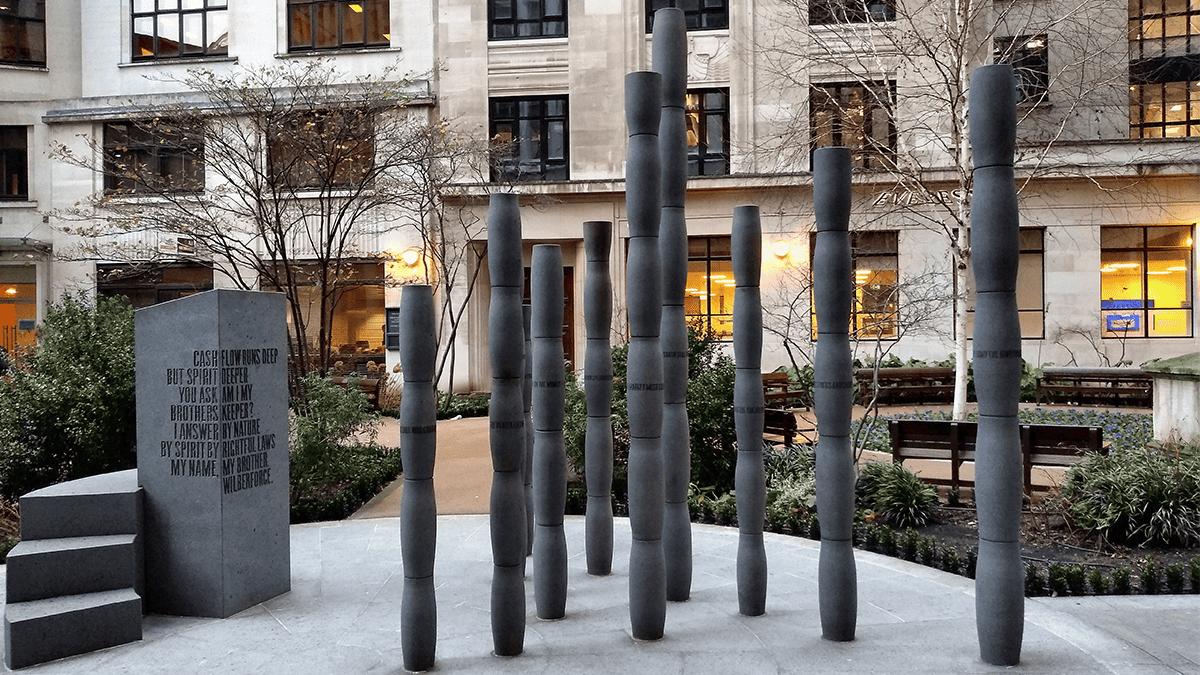The City of London is FULL of statues. Some are intended to show our pride in our nations’ leaders and great individuals, others represent historic events.
The City of London Corporation even states that “around almost every corner in the city you will find an unusual piece of public art or a commemoration of the City’s great history.”
Perhaps the City’s most famous statues are the dragons. They guard the major entrances to the city and are symbols of protection in heraldic terms. They carry the City’s shield with its ancient coat of arms, the cross of St George and a small red sword. Probably the fanciest is on the Temple Bar Memorial in Fleet Street.
Monument
Now, while the Monument isn’t exactly a statue, if you look up, you’ll see a flaming gilded urn at the top which symbolises the Great Fire of 1666.

The Monument stands 62 metres high and is exactly 62 metres from where the fire started in Pudding Lane.
It was designed by Sir Christopher Wren and Dr Robert Hooke, and was built on the site of St Margaret’s, the first church to burn down in the blaze.
Embed from Getty ImagesTake a close look at some of the engravings on the side of the Monument. One shows triumph over the fire with King Charles II dressed as a Roman Soldier showing his strength.
Gilt of Cain
The sculpture at Fen Court commemorates the abolition of the transatlantic slave trade in 1807, which began the process of the emancipation of slaves throughout the British Empire. It’s called the Gilt of Cain and is a powerful sculpture by Michael Visocchi and Lemn Sissay.

As you can see, the granite sculpture is composed of a group of columns surrounding a podium. The podium looks a bit like a pulpit or perhaps a slave auctioneer’s stance, whilst the columns are meant to make you think of either stems of sugar cane which the slaves would have picked, or perhaps a church congregation ready to listen to a speaker.
The sculpture’s named after a poem called Gilt of Cain and you can see some extracts from the poem carved in the granite. Something else to look out for is the way the poem skilfully weaves the coded language of the City’s stock exchange traders with biblical references.

The sculpture was placed here for historic reasons. Fen Court is the site of a churchyard formerly of St Gabriel’s and is now in the Parish of St Edmund the King and St Mary Woolnoth, a parish with strong historical connections with the move to abolish slavery. The Rev John Newton, a slave trader turned preacher and abolitionist, was rector here from 1780-1807.
James Henry Greathead
At Cornhill is the statue of James Henry Greathead. Now, you might be forgiven for thinking it’s a statue of Indiana Jones or some other swashbuckling adventurer – a mysterious fedora-wearing man, unfolding what appears to be a map.

That map isn’t a foreign land or showing where treasure is hidden – it’s actually the blueprint for what would become the Northern line! Greathead was born in South Africa in 1844, moving to England to study civil engineering at a time when engineering was coming on in leaps and bounds, creating tunnels, railways and steam engines the like of which had never seen before!
Whilst Marc Brunel and his son Isambard had successfully opened the first tunnel to run beneath the Thames a year before Greathead’s birth, Greathead would become renowned for building a ‘tunnelling shield’ that both helped protect the tunnellers and used new technology including water jets to help with the digging.

There’s some surprises about this statue. First of all, it’s not quite as old as you might think! It was designed by James Butler in 1994. As for the rather grand pedestal, well, that conceals a huge ventilation shaft for the Underground.
Other statues around Cornhill celebrate London soldiers killed in the Great War and the Duke of Wellington.
London Stone
At 111 Cannon Street you can find the London Stone on display in an iron grille box at ground level in the wall of the building.

The London Stone is pretty much what it sounds like! It’s not just any stone though, it’s a historic landmark made of an irregular block of oolitic limestone and is thought to be a remnant of something much larger.
It stood for many centuries on the south side of the street, and its existence was first recorded around the year 1100!

Now, we don’t really know exactly how long the stone has been in London or what it was even for but it’s thought to be possibly of Roman origin and could have been a milestone because its location is close to what would have been the centre of Roman Londinium.
Others have all sorts of theories, some even thinking it has magical powers! Imagine if the stone could talk! It’s witnessed so much of London’s history, surviving the Great Fire and the blitz.
The Cordwainer
The Cordwainer in Watling Street is a statue of a seated working man.

It was designed by Alma Boyes and commemorates the Ward of Cordwainer. A cordwainer was a shoe maker or leather worker. The name ‘Cordwain’ is a corruption of ‘Cordovan’, the English word for fine Spanish leather.
The Andalusian city of Córdoba was renowned for the manufacture of supple, yet strong and waterproof leather. Many of London’s cordwainers plied their trade in Bow Lane, a road that was called Cordwainer’s Street in the Middle Ages.

The statue reminds people about the Guild of Cordwainers that was established in 1272 and the important trade the cordwainers brought to the city. Watling Street itself is a famous Roman road, and one of the arterial roads of that period, running from Dover through London and onto St. Albans.
Nail
At One New Change is the Nail and it’s hard to miss!

It’s hammered between ancient and modern buildings of the city, some say to join these two worlds together. It’s designed to make you think about the past and the future and how manmade things can be worn away over time. It’s a whopping 12 metres tall and is made of copper.
Its scale is almost funny, what is normally a tiny object blown up to an enormous size. It’s as if we’ve shrunk! It might make you think of phrases about things coming to an end, like “nail in the coffin” and “nailed to the cross.”
A rather more cheerful thing to notice is that from a certain angle, Nail appears to pin the shopping centre to the ground.
Gardener Statue
In Brewers’ Hall Garden is the Gardener Statue.

It’s easy to take our natural spaces for granted, especially those within our cities and the City of London wouldn’t be anywhere near as nice without its gardens and green spaces. This statue is a tribute to all the green-thumbed workers who tend London’s public parks and gardens.
You might not know this but there’s an organisation within the City of London called the Trees Gardens and Open Spaces Committee. They’re in charge of keeping London gardens and parks in order.
They commissioned this statue, designed by Karin Jonzen, in 1971 to celebrate all those whose hard work keeps the grass trimmed and the flowers blooming.
Minatour
In Saint Alphage Gardens is a statue of a Minatour.
Now you might know that the Minotaur is a character from Greek Mythology – but do you know the story? The Minotaur was a creature with the head of a bull and the body of a man, who lived in a labyrinth on the island of Crete.

King Minos demanded that Athens send seven young men and seven young women as sacrifices to the Minotaur every nine years. Theseus, a prince of Athens, volunteered to be one of the sacrifices, hoping to kill the Minotaur and end the sacrifices once and for all. With the help of King Minos’ daughter, Ariadne, who gave him a ball of string to help him navigate the labyrinth, Theseus was able to defeat the Minotaur and escape with the other Athenian youths.
Designed by Michael Ayrton, the statue was initially in Postman’s Park near St Pauls, and moved here in 1997.
Some people think it’s particularly well placed here because getting in and out of the Barbican can be a bit like wandering through a maze!
Dance’s Obelisk
In Circus Place there’s a strange object, it’s Dance’s Obelisk and is based on one designed by George Dance the Younger which was originally placed in the centre of St George’s Circus in Southwark in the 1770s.

This one is much newer, and in fact is another ventilator for the underground.
As the City Surveyor, George Dance laid out the Finsbury Estate. Finsbury Circus Garden itself dates to 1606 and is the oldest public park in London.
The Kindertransport
Our final statue is in Liverpool Street, it’s called The Kindertransport. It’s a modern statue in bright bronze with five children, their bags and possessions standing in front of a railway line.

Although the children seem to be strong and confident, looking eagerly at their surroundings, it actually tells a story which whilst hopeful, also speaks of sadness. Just before outbreak of the Second World War, ten thousand Jewish children travelled unaccompanied to Britain to escape persecution in Germany and Austria.
This is what was known as The Kindertransport, Kinder being the German word for children. The children arrived here at Liverpool Street to be taken in by British families and foster homes. Sadly only a few were reunited with their families after the war.

You might be able to see that the children are wearing numbered tags. It’s sombre to think that many children would not have been as lucky and whilst they would also have been numbered, it would be with tattoos in concentration camps.
The statue was made in 2006 by Frank Meisler and Arie Oviada.
It might be nice to take some time to think about how brave these children must have been. Perhaps you can think about what their names were and what they liked to do by looking for details in the possessions included in the sculpture.
Some other statues that you might want to check out are:
- Shepherd and Sheep in Paternoster Square by St Paul’s Cathedral – A bronze sculpture by Elisabeth Frink which references Newgate Meat Market that stood there from the late 17th century until Smithfield took its place.
- Bellerophon Taming Pegasus in Finsbury Avenue – In Greek mythology, Bellerophon tamed Pegasus with a golden bridle from the goddess Athena and with the horse’s help accomplished a series of tests Zeus had assigned him. Depicting Bellerophon and Pegasus. It was the final sculpture worked on by Jacques Lipchitz and is in a style called Cubism. What you can see is actually a 12 foot bronze cast that’s about half the size of the original which is in New York.
- Hodge the Cat at Dr Johnson’s House in Gough Square – Hodge was the treasured companion of Samuel Johnson, an 18th century man of letters and whose most famous work is the Dictionary of the English Language. He was also a BIG cat lover – unlike us pigeons!
Add a comment
London’s History
London has a rich and full history that we can't wait to tell you all about! From The Romans of Londinium to the Tudors of London, it's all here.
More From London’s History







